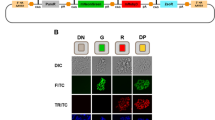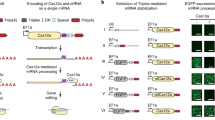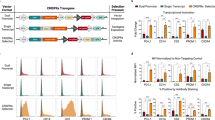Abstract
Silencing induced by long terminal repeat (LTR)–encoded cis-acting response element, termed SILENCE, is a forward genetic system that allows for conditional, epigenetic control of host-gene transcription. This new research tool is independent of gene mutation or disruption, does not require complementation, and conditional gene repression appears complete at the level of protein function. SILENCE functions in hypodiploid cells and is a platform technology with broad applications in gene discovery.
This is a preview of subscription content, access via your institution
Access options
Subscribe to this journal
Receive 12 print issues and online access
$259.00 per year
only $21.58 per issue
Buy this article
- Purchase on Springer Link
- Instant access to full article PDF
Prices may be subject to local taxes which are calculated during checkout



Similar content being viewed by others
References
Bradley, K.A., Mogridge, J., Mourez, M., Collier, R.J. & Young, J.A. Nature 414, 225–229 (2001).
Liu, S. & Leppla, S.H. Mol. Cell 12, 603–613 (2003).
Vanhecke, D. & Janitz, M. Drug Discov. Today 10, 205–212 (2005).
Dupuy, A.J., Akagi, K., Largaespada, D.A., Copeland, N.G. & Jenkins, N.A. Nature 436, 221–226 (2005).
Hobbie, L., Fisher, A.S., Lee, S., Flint, A. & Krieger, M. J. Biol. Chem. 269, 20958–20970 (1994).
Deuschle, U., Meyer, W.K. & Thiesen, H.J. Mol. Cell. Biol. 15, 1907–1914 (1995).
Gossen, M. & Bujard, H. Proc. Natl. Acad. Sci. USA 89, 5547–5551 (1992).
Wu, X., Li, Y., Crise, B. & Burgess, S.M. Science 300, 1749–1751 (2003).
Wiznerowicz, M. & Trono, D. J. Virol. 77, 8957–8961 (2003).
Boerger, A.L., Snitkovsky, S. & Young, J.A. Proc. Natl. Acad. Sci. USA 96, 9867–9872 (1999).
Milne, J.C., Blanke, S.R., Hanna, P.C. & Collier, R.J. Mol. Microbiol. 15, 661–666 (1995).
Scobie, H.M., Rainey, G.J., Bradley, K.A. & Young, J.A. Proc. Natl. Acad. Sci. USA 100, 5170–5174 (2003).
Livak, K.J. & Schmittgen, T.D. Methods 25, 402–408 (2001).
Jin, Y.F., Ishibashi, T., Nomoto, A. & Masuda, M. J. Virol. 76, 5540–5547 (2002).
Bulliard, Y., Wiznerowicz, M., Barde, I. & Trono, D. J. Biol. Chem. 281, 35742–35746 (2006).
Forrai, A. & Robb, L. Exp. Hematol. 33, 845–856 (2005).
Guo, G., Wang, W. & Bradley, A. Nature 429, 891–895 (2004).
Suzuki, T., Minehata, K., Akagi, K., Jenkins, N.A. & Copeland, N.G. EMBO J. 25, 3422–3431 (2006).
Acknowledgements
This work was supported by US National Institutes of Health awards AI-057870 and AI-59095. D.J.B. was supported by National Institutes of Health Microbial Pathogenesis Training Grant 2-T32-AI-07323. Flow cytometry was performed in the UCLA Jonsson Comprehensive Cancer Center (JCCC) and Center for AIDS Research Flow Cytometry Core Facility, which is supported by National Institutes of Health awards CA-16042 and AI-28697, and by the JCCC, the UCLA AIDS Institute and the David Geffen School of Medicine at UCLA. We thank P.J. Bradley for helpful suggestions and insight.
Author information
Authors and Affiliations
Corresponding author
Ethics declarations
Competing interests
The authors declare no competing financial interests.
Supplementary information
Supplementary Table 1
Oligonucleotide sequences.
Rights and permissions
About this article
Cite this article
Banks, D., Bradley, K. SILENCE: a new forward genetic technology. Nat Methods 4, 51–53 (2007). https://doi.org/10.1038/nmeth991
Received:
Accepted:
Published:
Issue Date:
DOI: https://doi.org/10.1038/nmeth991
This article is cited by
-
CHD1 and CHD2 are positive regulators of HIV-1 gene expression
Virology Journal (2014)



